I will assume that just about everyone reading this already knows such a bird actually does exist. I will also assume some of you have hunted snipe before. However, sometimes the difference between bringing home birds and just coming home worn out from walking a few miles over marginal ground can be almost as dependent on fine details as where you hunt. Granted, if you don't have birds you won't shoot them but even in areas where there are great fall concentrations of snipe some people seem to do better at bringing a few home than others.
Like most people that have spent years pursuing snipe my success improved considerably with experience. My first hunt was almost forty years ago when a friend introduced me to it. For the first few years my success was extremely limited. When I finally shot that first snipe something unique happened and I consider it a sign that I was destined to be a hunter of snipe above all other game birds. The first time I shot a snipe I killed two with one shot. Those might have been the only two snipe I shot that year but I was hooked and every Saturday and sometimes on Sunday I did my best to try and add another one to the pair in the freezer. In the end I still had enough just for a meal for me. However, as years went on I got better with my hunting technique and more birds ended up in my game bag. Before I go any further, I want to clarify something. Killing a large number of birds isn't the best reason to hunt but there is no reason anyone should ever have to apologize for shooting any quantity of birds as long as they are within the limits of the law.
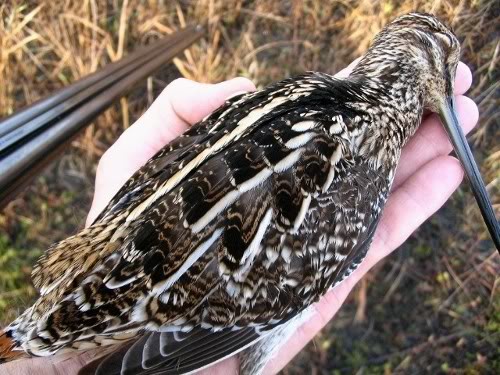
The first subject I want to discuss is the various snipe hunting methods. Where you hunt will likely dictate which is most productive. The most common methods for hunting snipe involve hunting behind a pointing dog, walking up birds, or pass shooting. Driven shooting which involves beaters pushing birds to guns is popular on shooting estates worldwide but for most hunters in the United States the three methods first mentioned are the way snipe are hunted. The majority of my hunting has always been walking them up along the edge of shallow natural lakes. This simply consists of walking likely areas and shooting at flushing birds. In this method the majority of the shots will be at birds that are going away. The same is true when hunting over a dog, the exception being that with a dog you are anticipating a flush when the dog goes on point. When walking up birds you have nothing to alert you but the bird itself so when hunting this way it is imperative that you are ready at all times. It has almost always been written that snipe make a "scaipe" sound when they flush and while that is true the vast majority of the time many also flush without making a sound. Keep your eyes and ears constantly alert when walking up snipe.
Both of the above hunting methods require some ground cover. I prefer grass that is about knee high. I find the majority of birds to be in open spots and most likely along the edge of the water. The birds are there feeding and most of that diet consists of worms and small invertebrates on the freshwater marshes I hunt. I pay attention to soil content and while you can find birds in sandy areas, the better ones for me have always been flats that are more mud than sand. The birds prefer those areas because what they are feeding on prefer it. It is my belief that you need a little more cover when using a dog but you might find that the birds in your area will hold well for a point even if the cover is sparse, especially if the hunting pressure is light.
When either hunting over a pointing dog or by the walk-up method you can also have some opportunities for passing shots. Many times it has been written that after being flushed a snipe will often circle back to the spot from where they flushed presenting shots at incoming or overhead birds. Perhaps it is a result of heavy gunning pressure but where I have done my hunting most flushed birds fly until they are out of sight. They will eventually return to that mud flat but it isn't immediate and sometimes not the same day. I mention this because what I have experienced does not support what I have most often read so it might or might not be the case for you.
Pass shooting is what most of us do when hunting ducks and dove but for some people it is also the most common way to hunt snipe in cultivated fields or pastures. I have hunted snipe in a cow pasture that was as barren as a mall parking lot. A tight sitting bird was one that flushed at fifty yards and for most of them nearly twice that distance was more likely the norm. When those are the conditions you are either going to be pass shooting or just going for a walk through a muddy pasture. A few areas of standing water will draw birds and a couple of people spread out can keep some birds moving about. Shots tend to be longer in my experience for this type of shooting than with the other methods and I might find that a different choice of gun and/or choke than what would be ideal in heavier cover is needed when hunting this way. I can still hear my friend from Gainesville repeatedly saying to me one day last year, "Don't be afraid of the long shot". He wasn't kidding.
I would consider this to be nearly ideal habitat when looking for places likely to hold snipe, as long as it provides food. It has adequate cover, water, and shore area.
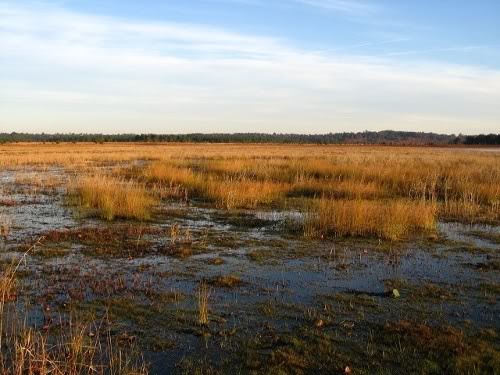
Another area likely to hold some snipe if food is available. The slightly sparse cover might make shots longer than if it was a little bit denser.
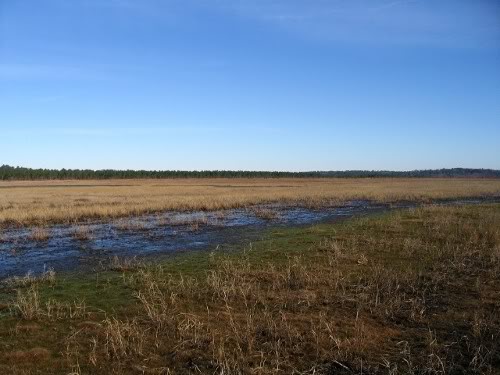
This picture shows an area that drained rapidly. At this point there isn't enough cover to conceal an approaching hunter so walk-up shooting might be difficult if hunting alone. A couple of hunters spread out and walking near water holes should be more successful and will likely get some passing shots at incoming birds. Otherwise, a single hunter might just flush birds and push them from one area to another, never getting much shooting.
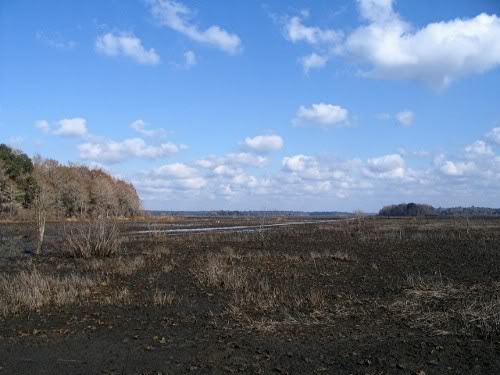
This is more like pasture hunting. If the birds have seen any hunting pressure at all it is unlikely that you will be able to jump shoot birds with practically no cover. If there is only one water hole the birds will return to it after flushing unless they leave the area altogether. While this looks much different than the last picture I would hunt both areas the same way.
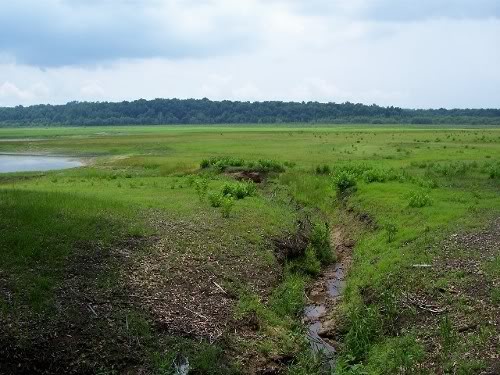
Next we should discuss guns and loads. What do I recommend? Any shotgun and load you like that will kill effectively at the maximum range at which you intend to shoot. It's a simple as that. I use lead shot in sizes from # 7 1/2 to # 9. I'm sure something outside of that range of shot could also be used but I have never felt it necessary to go beyond those sizes in either direction. What gauge you use, type of action, barrel length, choke, etc. are all personal choices and should be influenced by what you feel you want and need. I know what I like but far be it from me to claim to know what would work best for someone else. Use a gun you have confidence in because that is the one you will shoot best. Snipe are fragile birds and anything in the aforementioned shot size range will break bones and drop birds at any acceptable distance. I tend to go with smaller sized shot with smaller payloads in the smaller gauges to give adequate pattern density. Check your gun at different distances to get an idea of how effective your pattern is.
Okay, we've got the methods down and the basics of equipment. Now we have to find the birds. Pastures, fields, and lakes are all over the state I live in. Some people I know are not having a good year because they haven't had enough rain this year. For me not enough water is never the problem. Too much water is. The best advise I can give you is to look for likely spots and see if they hold birds. Some years I do some preseason scouting but after a few decades I can just about check the water level at a few spots and know which will be best for a given season provided we don't get a deluge of rainfall. I wish there was a shortcut to experience to locating the best places but there isn't. You can get to that point and no doubt many people reading this already are but first you are going to have to do some leg work. For me it helped going through that stage as a teenager when I had considerably more stamina than I have today.
Once you find birds you will learn to hone the fine details that will make you more successful. I believe I used those two words in the third sentence of this article. There is one thing I can guarantee, where I walk has a bearing on how many shots I get in a day. I don't mean walking a completely different area but just a few yards can make a big difference. That might sound odd that something so seemingly insignificant could have any bearing at all but it does. One of the first things you will notice when walking the shore of a marsh like I typically hunt is where the birds are at a given time on a given day. Generally, if it has been raining or the ground is heavily saturated the birds will be further away from the water. This can be from a few yards to as much as twenty-five or thirty yards. If the ground is dry the birds might be right on the edge of water or even sitting in the grass well out into the water. Before we had heavy rains here over the past two weeks I was flushing a number of birds in a couple of areas as much as fifty yards into the water. They were just out there resting where they felt safe since they don't feed where the water is knee deep. They will not be in the same place when resting as they are when feeding so I let the first couple give me an indication of where most of them are likely to be. If you are walking parallel to and twenty yards off the shoreline and the birds are flushing right at the edge of the water, you are not as likely to get as many shots as if you were only ten yards from the water. Similarly, if birds are sitting twenty yards from the water and you are walking right along the edge you have put yourself at an unnecessary disadvantage. I have hunted a few times with people that I met at the lake but didn't know other than having seen them out there before. There are two thing I usually notice. They take a different path than I take and they get fewer opportunities at birds. Paying attention to detail is very important to success. Another issue that I have read about in every snipe hunting book I own concerns wind. It is always recommended that you walk with the wind at your back. The consensus is that birds flush into the wind and therefore will flush toward you instead of away from you. Yes, no, maybe. Perhaps in a thirty mile per hour gale a bird would choose not to takeoff downwind but I have seen more than a few thousand snipe flush into and against a slight wind at every conceivable angle. If the wind blows from a constant direction and you are walking around a somewhat circular body of water you will deal with the wind from all sides at some point. What do I do? I don't worry about the wind. What I do worry about is the sun. I shoot fine with the wind in my eyes, but walking directly into the sun makes seeing low flying snipe tough, especially if it is low on the horizon early in the morning or late in the afternoon. A low flying, zigzagging snipe is tough enough to bag without adding an additional handicap. If given a choice, put the sun to your back and then consider wind direction.
Lastly I will discuss snipe hunting apparel and comfort. I don't know where you hunt but where I hunt I am much more likely to get hot than cold. Granted, a few weeks ago the water was frozen and the grass crunchy with twenty-something degree temperatures. However, that doesn't happen often and even when it does by mid morning the temperature is probably going to be back into the sixties. When I hunt I wear a short sleeve ventilated cotton shirt like the Columbia White Wing. On cold days I like a pullover sweater and by 9:00 I am usually ready to come out of it. It's easy to deal with because you can tie it around your waist and keep on going. I have several game vests but rarely wear one. If you are already going to be uncomfortably warm why make it worse with another layer? Strap vets are a little better than a full vest but not by much. Get a set of waist bags. Filson makes a very nice set but it goes for a little over $100. If you are like me and not inherently wealthy you can spring for one of the inexpensive sets like the one Gamehide makes. I got mine off ebay and don't have $10 in it including shipping. Because I walk through some deep holes and knock birds down over water hip waders are mandatory for me. They might not be for you. I know people that wear a pair of waterproof Sealskinz socks and they swear by them. They stay dry enough in them while wearing jeans and leather hunting boots. That would be a good warm weather choice if waders are too hot for you. If I chose the waterproof socks I would elect to wear wading boots. When getting wet and dry repeatedly they will hold up better than traditional hunting boots. When I was young all I wore was jeans and boots. At my current age walking around in wet pants and socks is more than I want to endure. The first dozen or so pairs of waders I wore were the standard rubber ones. They are hot but are not too difficult to patch when a stick punctures them. If I had no other choice I'd have no aversion to wearing them today but I decided at some point to move to neoprene. They are more flexible than rubber but I'm not so sure they are any cooler. Still, from a comfort standpoint I prefer them to rubber. Last year I got my first pair of breathable hip waders. If you have used all three types of waders you know how much nicer they are than the other choices. They aren't as tight as neoprene so air circulates better. That keeps you cool. They weigh next to nothing so that doesn't tire you as quickly. So far they are every bit as durable as anything else and far more comfortable. With a pair of lightweight cordura wading boots, the whole setup doesn't feel any different than a pair of pants and lightweight hiking boots.
Now for a quick summary. Start by finding potential spots and narrow them down until you find where the birds are. Usually if you find similar conditions elsewhere you are likely to find birds there also. Dress with an emphasis on staying comfortable. Choose a gun you feel most confident shooting regardless of what you have read or someone told you is best. All that's left is a few recipes that will make you wonder why you have been missing out on something so good for so long. We'll cover that subject in another article.


